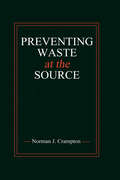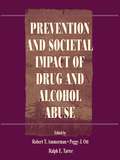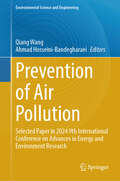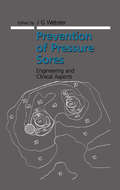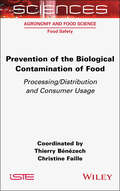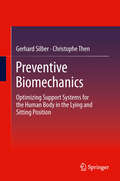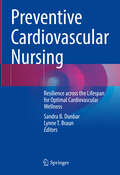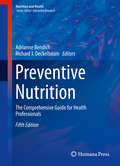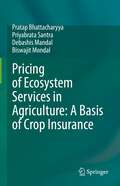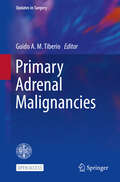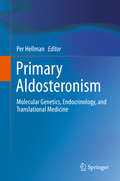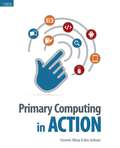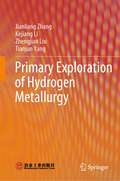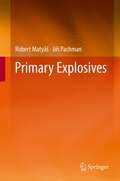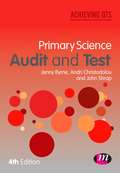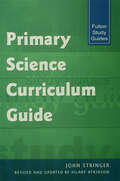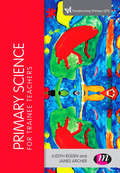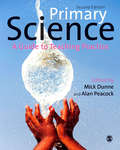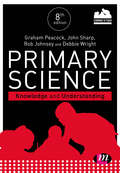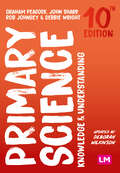- Table View
- List View
Preventing Waste at the Source
by Norman J. CramptonAfter a day's work is finished, take a look around at your company. Do standard production processes and day-to-day operations leave you with loaded trash bins from the front office to the factory floor-and every place inbetween?Such "solid waste" does far more than squander resources and imperil the environment... it's undoubtedly eating up countless dollars of your profits.Corporations throughout the nation are learning to tame solid waste, by implementing improved management of materials. Preventing Waste at the Source demonstrates how more than 50 companies have effectively reduced solid waste throughout all departments-and achieved dramatic reductions in operating costs.Beginning with a strategic framework, readers can then zero in on wasteful practices affecting all aspects of a business. Paper reduction measures for administrative offices, for instance. Ways to minimize packing materials over in the shipping department, while still protecting the product. There's also steps where suppliers and customers can take part in waste minimization efforts. Case histories prove it can be done, to everyone's advantage.Researched and compiled by the Indiana Institute on Recycling, Preventing Waste at the Source offers practical, on-the-job assistance to environmental managers, plant managers, manufacturing and quality engineers. Put its techniques and real-life guidance to work. You'll save more than money: you'll help save the environment.
Prevention and Societal Impact of Drug and Alcohol Abuse
by Robert T. Ammerman Peggy J. Ott Ralph E. TarterIt is generally acknowledged that the most cost-effective means of curtailing alcohol and drug abuse is prevention. Providing interventions to at-risk individuals before they develop serious problems with substance use is the most important component of the "war on drugs." Fortunately, the past decade has seen a dramatic increase in the quantity and quality of scientific research on those areas crucial to the advancement of prevention science. This book compiles a tremendous amount of information about prevention which has accumulated in recent years. Documenting these accomplishments and setting the stage for future efforts comprise the focus of this book. Prevention and Societal Impact of Drug and Alcohol Abuse is divided into four parts. Part I contains introductory chapters addressing current issues in prevention science and characteristics of abusable substances. Part II includes chapters on the historical contexts of substance abuse and the deleterious health consequences of alcohol and other drugs. Part III focuses on the impact of drug and alcohol abuse on society. Included are chapters on alcohol and drug abuse and driving, infectious illness, disability, managed care, the criminal justice system and adolescents and adults, sale and distribution, the media, and community responses. Part IV consists of chapters on prevention in specific settings and with certain populations.
Prevention of Air Pollution: Selected Paper in 2024 9th International Conference on Advances in Energy and Environment Research (Environmental Science and Engineering)
by Qiang Wang Ahmad Hosseini-BandegharaeiThis book offers readers with analysis of the main causes and purification technology of air pollution.Air, as the primary element on which human life depends, directly impacts human living and health. However, a 2022 report from the World Health Organization indicated that "the air nearly the entire global population (99%) breathes exceeds WHO air quality limits, threatening their health". Currently, the main approaches to air pollution involve source control and the treatment of air pollutants.Analyzing the causes of air pollution is an effective method for controlling pollution from its source and preventing its spread. It is also an efficient and rapid way to identify harmful gas components and then apply targeted treatment.Currently, big data model analysis and sensor perception technology are widely used analytical techniques. Combined with chemical transport models, they can simulate and predict pollutants, achieving better causal analysis and forecasting.Additionally, air pollution purification is an important component of prevention of air pollution.Currently, the most important research direction is how to purify air pollution without causing secondary environmental contamination, in addition to physical and chemical means.This book provides engineers and researchers in the field of air pollution prevention with research findings related to this area. It aims to share specific and valuable knowledge and content to improve prevention of air pollution efforts.
Prevention of Pressure Sores: Engineering and Clinical Aspects
by J.G WebsterPrevention of Pressure Sores: Engineering and Clinical Aspects collects together material from throughout the literature. The book first discusses the causes of pressure sores and then describes warning signs and behavior to prevent the incidence of pressure sores. It also examines the numerous different devices used to alleviate and prevent pressure sores, including various types of seat cushions, hospital beds, complex pressure relief methods, wheelchair pressure reliefs, and other preventative methods. After comparing the accuracy of various methods of measuring pressure distributions using different types of sensors, the book discusses the treatment of pressure sores. It contains a large number of references, allowing readers to refer back to the important original work in the different fields of this subject.
Prevention of the Biological Contamination of Food: Processing/Distribution and Consumer Usage
by Thierry Bénézech Christine FailleThis book deals with risk management by focusing on microbiological risks. Throughout the food chain, foodstuff may be exposed to dangerous agents that can potentially affect its quality and thus the health of consumers. A good knowledge of the strategies and means of control implemented along the food chain after the primary production stage is a necessary condition and a prerequisite for any further improvement, but it is not sufficient. Indeed, in order to better prevent and therefore control these risks, it is essential to study both the phenomena of surface contamination and those relating to the elimination of this contamination by cleaning and disinfection operations in order to know the main mechanisms. Thanks to this, a certain number of innovations can already be proposed (new surfaces, new materials and cleaning and disinfection procedures, etc.) for future developments on an industrial or domestic scale.
Preventive Biomechanics
by Christophe Then Gerhard SilberHow can we optimize a bedridden patient's mattress? How can we make a passenger seat on a long distance flight or ride more comfortable? What qualities should a runner's shoes have? To objectively address such questions using engineering and scientific methods, adequate virtual human body models for use in computer simulation of loading scenarios are required. The authors have developed a novel method incorporating subject studies, magnetic resonance imaging, 3D-CAD-reconstruction, continuum mechanics, material theory and the finite element method. The focus is laid upon the mechanical in vivo-characterization of human soft tissue, which is indispensable for simulating its mechanical interaction with, for example, medical bedding or automotive and airplane seating systems. Using the examples of arbitrary body support systems, the presented approach provides visual insight into simulated internal mechanical body tissue stress and strain, with the goal of biomechanical optimization of body support systems. This book is intended for engineers, manufacturers and physicians and also provides students with guidance in solving problems related to support system optimization.
Preventive Cardiovascular Nursing: Resilience across the Lifespan for Optimal Cardiovascular Wellness
by Sandra B. Dunbar Lynne T. BraunThis book provides a comprehensive overview of essential concepts and evidence that guide the practice of contemporary preventive cardiovascular nursing. The sections incorporate a lifespan approach to cardiovascular wellness, and provide perspectives on sources of known and emerging cardiovascular risk factors as well as the spectrum of multidimensional factors including biological, behavioral, psychological and sociocultural influences on cardiovascular wellness, risk, and the evolution of cardiovascular conditions. Unique features address: 1) building resilience across the lifespan such that optimal cardiovascular wellness can be attained within multiple contexts of health states to increase a healthy lifespan and longevity; 2) behavior change skills for risk factor reduction; 3) risk factors and risk reduction approaches with special populations defined by gender, , age and aging, heath states, and health equity issues; and 4) high level roles for cardiovascular nurses as provider - risk assessor, communicator and care provider; educator, leader, patient and health advocate. Relevant case studies are included throughout to facilitate the application of the content. This book fills a gap in that there is no other book on preventive cardiovascular nursing care and roles , and it provides support for the nurse to lead relevant interdisciplinary teams. The book will empower nurses to build knowledge and skills for cardiovascular prevention and to provide leadership for optimal cardiovascular wellness for patients and communities.
Preventive Nutrition
by Richard J. Deckelbaum Adrianne BendichEvidence-based nutritional interventions are now a critical component of preventive medicine, employed in a wide variety of medical scenarios. Preventive Nutrition: A Comprehensive Guide for Health Professionals, Fourth Edition gives health professionals up-to-date, comprehensive reviews that evaluate the dietary practices and interventions that have been shown to reduce disease risk and improve health outcomes. This is the flagship volume for the book series, Nutrition and Health, which has become an essential tool for health professionals. As the state of global health and nutrition have changed much since the publication of the Third Edition, this major revised and expanded Fourth Edition includes newly authored chapters and features analysis of the results of the Women's Health Initiative, the largest intervention study ever undertaken and completed in postmenopausal women. Other new material includes chapters reviewing the evidence concerning econutrition, micronutrients and major cancers, and cognitive function and other mental health areas. Also discussed are the importance of gastric acid secretions, the nutritional effects of current therapies, and the latest information on the biology of obesity and its relationship to Type 2 diabetes. One key new feature of this edition is a chapter on behavioral strategies to help assure compliance with dietary regimes, maximizing the health benefits of preventive nutrition. The authors have created the most comprehensive and up-to-date review of the nutritional strategies available for the prevention of disease and the promotion of health through nutrition. Patients are looking for credible information from their health care providers about a whole range of subjects covered here, including ß-carotene, lycopene, antioxidants, folate, and the myriad of bioactive phytochemicals found in garlic and other foods. With sections on cardiovascular disease, diabetes, and pregnancy among many others, this volume will be of great value to practicing health professionals, including physicians, nutritionists, dentists, pharmacists, dieticians, health educators, policy makers, health economists, regulatory agencies and research investigators. An entire section covers nutrition transitions around the world including Eastern Europe, Latin America and Asia as well as goals for preventive nutrition in developing countries.
Pricing of Ecosystem Services in Agriculture: A Basis of Crop Insurance
by Debashis Mandal Pratap Bhattacharyya Priyabrata Santra Biswajit MondalThe book deals with the pricing of ecosystem services provided by agriculture. All provisioning, regulating, supporting and cultural services are being covered in this title. Chapters in this contributed volume cover topics such as pricing of services from the soil, water, and nutrient management. Quantified monetary values of carbon sequestration and renewable energy applications in agriculture are covered with clear-cut methodologies. This book also links ecosystem service-based pricing with crop insurance. Improving the farmers’ livelihood is the central goal of the agricultural production system throughout the world. Under the climate change context, farms’ produce is now climate-vulnerable and heavily dependent on weather conditions. Moreover, we often neglect the contribution of several positive impacts of agricultural practices on ecosystems and natural resources. Therefore, there is a need to quantify and value these ecosystem services in agriculture. However, valuation and pricing the services in agriculture both tangible and intangible is a challenge. It is necessary to have clear-cut methodologies for pricing ecosystem services of agriculture in terms of net monetary benefits. The ecosystem service-based pricing could be a solid basis for calculating the insurance to farmers in case of occurrence of natural hazard and associated crop damage. This book is of interest to scholars, teachers, researchers, environmental scientists, watershed managers, capacity builders, and policymakers. The book also serves as effective reading material for undergraduate and graduate students of agriculture economics, ecology, agronomy, and environmental sciences. National and international agricultural scientists, policymakers will also find this to be useful.
Primal Wisdom of the Ancients: The Cosmological Plan for Humanity
by Laird ScrantonExamines how the similarities of symbols and wisdom across many cultures point to an ancient civilizing plan and system of ancient instruction • Reveals the shared cosmological knowledge of Dogon and Maori cultures, ancient Egypt, Gobekli Tepe, Vedic India, the pre-Indian Sakti civilization, Buddhism, the Tibetan Bon religion, and the kabbalistic tradition of the Hebrews • Explores symbols and techniques used to frame and preserve instructed knowledge as it was transmitted orally from generation to generation • Explains how this shared ancient knowledge relates to the precessional year and the cycles of time known as the yugas Exploring the mystery of why so many ancient cultures, separated by time and distance, share remarkably similar cosmological philosophies and religious symbolism, Laird Scranton reveals how this shared creation tradition upholds the idea that ancient instruction gave birth to the great civilizations, each of which preserves fragments of the original knowledge. Looking at the many manifestations of this shared cosmological knowledge, including in the Dogon and Maori cultures and in ancient Egypt, Gobekli Tepe, Vedic India, Buddhism, the Tibetan Bon religion, and the kabbalistic tradition of the Hebrews, Scranton explores the thought processes that went into formulating the archetype themes and metaphors of the ancient symbolic system. He examines how commonly shared principles of creational science are reflected in key terms of the ancient languages. He discusses how the primal cosmology also transmitted key components of sacred science, such as sacred geometry, knowledge of material creation, and the nature of a nonmaterial universe--evidence for which lies in the orientation of ancient temples, the drama of initiations and rituals, and countless traditional myths. He analyzes how this shared knowledge relates to the precessional year and the cycles of time known as the yugas. He also explores evidence of the concept of a nonmaterial twin universe to our own--the &“above&” to our &“below&” in the famous alchemical and hermetic maxim. Through his extensive research into the interconnected wisdom of the ancients, Scranton shows that the forgotten instructional tradition at the source of this knowledge was deliberately encoded to survive for countless generations. By piecing it back together, we can discover the ancient plan for guiding humanity forward toward greater enlightenment.
Primary Adrenal Malignancies (Updates in Surgery)
by Guido A. M. TiberioDissemination of knowledge is the best and only strategy capable of improving clinical management in rare and ultra-rare malignancies, including primary adrenal malignancies. It is preliminary to any further healthcare policy such as, for example, the centralization of cases in referral institutions. Adrenal primary malignancies are probably the rarest among rare pathologies. This epidemiological consideration is at the origin of a vicious circle: the lack of preoperative diagnosis leads to inappropriate surgical procedures and to inadequate follow-up and systemic therapy strategies. Furthermore, when malignancy is recognized, the relative role of systemic, surgical, or other local ablative techniques is often misinterpreted. All this produces a negative impact on survival, also in patients who could have been cured with a correct therapeutic strategy. This open access book provides a user-friendly exploration of these rare conditions, using a transversal approach common in modern precision medicine. The text covers various clinical aspects, including epidemiology, genetics, molecular medicine, imaging, and surgery. Guidelines for managing syndromic situations are provided. The book thoroughly addresses all the different surgical issues and emphasizes the importance of pathology in assessing prognosis. The pivotal role of medical oncologists in managing these patients is explored, along with alternative treatments such as nuclear medicine and radiotherapy. Finally, the book highlights the latest preclinical research and its implications for translational medicine.
Primary Aldosteronism
by Per HellmanPrimary Aldosteronism (PA) is a disease caused by the overproduction of aldosterone hormone from the adrenal glands. PA causes hypertension and the majority with this disease are undiagnosed for PA. There are new insights into this matter by using biochemistry as well as advanced radiology. In 2011, a breakthrough in the genetic derangements came, identifying a mutated potassium channel gene - KCNJ5 - in about 40% of PA with adenoma. Chapters in this book include a history of the disorder, epidemiology, genetics derangements, the KCNJ5 mutations and phenotype and more.
Primary Computing in Action
by Ben Sedman Yasemin AllsopPresenting practical ideas that support teachers and trainees with the planning, implementation and assessment of the 2014 Primary Computing Curriculum. Demonstrating how freely available apps and web-based applications, programmes for PCs and Macs, can be used creatively to design innovative and engaging activities in the Early Years, Key Stages 1 and 2. Covering all aspects of the 2014 primary curriculum, including computer science, digital literacy and information technology. Includes both plugged and unplugged activities.
Primary Computing in Action
by Ben Sedman Yasemin AllsopPresenting practical ideas that support teachers and trainees with the planning, implementation and assessment of the 2014 Primary Computing Curriculum. Demonstrating how freely available apps and web-based applications, programmes for PCs and Macs, can be used creatively to design innovative and engaging activities in the Early Years, Key Stages 1 and 2. Covering all aspects of the 2014 primary curriculum, including computer science, digital literacy and information technology. Includes both plugged and unplugged activities.
Primary Exploration of Hydrogen Metallurgy
by Jianliang Zhang Kejiang Li Zhengjian Liu Tianjun YangThis book is a monograph dedicated to hydrogen metallurgy technology in iron ore reduction in the world (mainly in China), aiming to accelerate the development of hydrogen metallurgy research and promote the low-carbon process in the iron and steel industry. This book mainly introduces the frontier theory and process technology of hydrogen metallurgy, focusing on the behavior and role of hydrogen in reducing iron ore. The specific contents include hydrogen production and storage technology, hydrogen direct reduction of iron oxide technology, hydrogen smelting reduction of iron oxide technology, plasma hydrogen reduction of iron oxide theory, and the behavior of hydrogen in blast furnace iron-making and sintering processes. This book provides a comprehensive and detailed description of the theories and process technologies involved in hydrogen metallurgy at the levels of fundamental theory, feasibility analysis, experimental studies, and industrial applications. This book can be usedas a reference for metallurgical engineering, iron, and steel metallurgy majors, as well as teachers and students, researchers, engineers, and enterprise staff interested in hydrogen and low-carbon metallurgy-related fields.
Primary Explosives
by Robert Matyáš Jiří PachmanThis is the first comprehensive overview of this topic. It serves as a single source for information about the properties, preparation, and uses of all relevant primary explosives. The first chapter provides background such as the basics of initiation and differences between requirements on primary explosives used in detonators and igniters. The authors then clarify the influence of physical characteristics on explosive properties, focusing on those properties required for primary explosives. Furthermore, the issue of sensitivity is discussed. All the chapters on particular groups of primary explosives are structured in the same way, including introduction, physical and chemical properties, explosive properties, preparation and documented use. The authors thoroughly verified all data and information. A unique feature of this book are original microscopic images of some explosives.
Primary Science
by John Sharp Graham Peacock Rob Johnsey Debbie WrightThis dictionary has been updated with new headwords, now over 650, makingit more comprehensive. Each entry is in alphabetical order and along with aclear and straightforward definition, has a funky colour illustration or diagramto help explain the meaning. Cross references link the user to other usefulwords in this dictionary so it is easy to build up vocabulary quickly. Thecolourful, modern design and artwork make it easy to pick out the word you need,and fully understand it.
Primary Science Audit and Test: Audit And Test (Achieving QTS Series)
by John Sharp Jenny Byrne Andri ChristodoulouIf you are a primary trainee, you must demonstrate a knowledge of science to be recommended for QTS. This popular, widely recommended, text helps you audit your knowledge of science and understand what learning you need to pass your course. A rigorous test helps you identify your strengths and weaknesses and can be revisited at key stages in your course as a tool to monitor and evaluate progress. The fourth edition has been updated in line with the new National Curriculum, includes more information on expanding and developing your knowledge of science and is linked to the 2012 Teachers' Standards.
Primary Science Curriculum Guide
by John StringerThis guide provides trainee teachers with an insight into the nature and teaching of primary science. It aims to introduce you to the ways in which children learn science, and to the science itself. Each Unit can be studied independently or used to support/prepare for school experiences. You will be directed towards additional reading, which will develop or confirm the subject knowledge you will need to achieve QTS. the curriculum guide is up-to-date, revised to take account of Curriculum 2000 and accepted 'good practice' in primary science teaching and learning. It is also flexible - many of the Units are stand-alone. They can be undertaken in any order, at your own pace, to complement school experiences. The Units are practical and feasible: the activities suggested can be undertaken by the non-specialist; in many cases without specialized equipment or access to large numbers of pupils. The guide is comprehensive, covering all the primary science elements in Curriculum 2000 and giving background information into other aspects of primary science teaching. It is also supportive - the guide suggests further texts to support trainees' own understanding of the scientific and pedagogical concepts involved. Additional reading draws on the TTA's list of approved key texts. The original text was piloted by students following a distance-learning PGCE course. It has been revised and updated in line with their comments and to meet Curriculum 2000 and Curriculum Guidance for the Foundation Stage. The text was initially developed as a core text for the part-time distance-learning course at Liverpool Hope and is designed for trainee teachers on distance learning and flexible routes, returning, converting or overseas teachers.
Primary Science Teaching Theory and Practice
by John Sharp Graham Peacock Rob Johnsey Shirley Simon Robin Smith Alan Cross Diane HarrisThe 6th edition of this popular core text provides the essential teaching theory and practice for primary science. It promotes effective teaching through secure pedagogical knowledge, covering the key skills of planning, monitoring and assessment and class management, and relating these specifically to primary science. This 6th edition is linked to the 2012 Teachers' Standards. With full coverage of the theory and practice required for effective and creative science teaching, this text is an essential guide for all trainees working towards QTS. Throughout, practical guidance and features support trainees to translate this learning to the classroom, embed ICT in their lessons and to understand the wider context of their teaching. Trainees will find it helpful to use this book alongside Primary Science Knowledge and Understanding. About the Achieving QTS series All the books in this successful series support trainees through their initial teacher training and guide them in the acquistion of their subject knowledge, understanding and classroom practice. All new titles within the series link to the 2012 Teachers' Standards and take into account recent changes in Initial Teacher Training.
Primary Science for Trainee Teachers
by James Archer Ms Judith RodenWith chapter sequencing following the new Curriculum, this book supports trainee Primary school teachers to make use of the opportunities presented in the new National Curriculum for effective and engaging Science teaching. Covering all of the areas of the new National Curriculum for primary science and offering insight into effective teaching, it helps you connect what you need to teach to how it can be taught. This comprehensive guide to teaching Primary Science will help you secure your subject knowledge, understand how children learn about science and know how to plan and teach effective and inspiring science lessons. Exploring opportunities in the new curriculum for creative and imaginative teaching, it shows you how to capitalize on opportunities to teach Science in a way that sparks children's interest. Includes the full National Curriculum Programme of Study for Science, key stages 1 and 2 as a useful reference for trainee teachers.
Primary Science: A Guide to Teaching Practice
by Alan Peacock Mick DunneWhy is science hard to teach? What types of scientific investigation can you use in the primary classroom? Touching on current curriculum concerns and the wider challenges of developing high-quality science education, this book is an indispensable overview of important areas of teaching every aspiring primary school teacher needs to understand including: the role of science in the curriculum, communication and literacy in science teaching, science outside the classroom, transitional issues and assessment. Key features of this second edition include: • A new chapter on science in the Early Years • A new practical chapter on how to work scientifically • Master’s-level ‘critical reading’ boxes in every chapter linking topics to relevant specialist literature • Expanded coverage of creativity, and link science to numeracy and computing This is essential reading for all students studying primary science on initial teacher education courses, including undergraduate (BEd, BA with QTS), postgraduate (PGCE, School Direct, SCITT), and also NQTs. Mick Dunne is Senior Lecturer in Science Education at Manchester Metropolitan University Alan Peacock is Honorary Research Fellow at the University of Exeter
Primary Science: Knowledge And Understanding (Achieving QTS Series)
by Debbie Wright Keira Sewell Professor John Sharp Mr Graham A Peacock Mr Rob JohnseyNow with online resources to support subject knowledge! Secure subject knowledge and understanding is the foundation of confident, creative and effective teaching. To help your students master this, the 8th edition of this established text now comes with a range of online resources available on the brand new companion website including: a comprehensive science subject knowledge audit reflective self-assessment questions per chapter a science subject knowledge checklist useful weblinks for primary science teaching You can use the science subject knowledge audit to assess your trainees’ progress and ensure they better understand their level of knowledge. Grading students' overall performance, highlighting areas for improvement linked to relevant chapter reading and the ability to share results with their lecturer, makes this the ideal science subject assessment tool. This 8th edition, covering the whole curriculum for primary science, has also been updated to include more on why science matters in primary schools and new content on ‘States of matter’, 'Rocks and soils’ and the 'Theory of Evolution'. New interactive activities are included to engage students in their learning and enable discussion. Using this book in conjunction with the free online resources really makes this the complete package for developing science subject knowledge.
Primary Science: Knowledge and Understanding
by John Sharp Graham Peacock Rob Johnsey Debbie WrightThe 6th edition of this popular core text is the essential subject knowledge book for primary science. Helping trainees to establish and consolidate a secure subject knowledge and understanding of primary science, it promotes the development of confident, creative and effective teachers. This 6th edition is linked to the 2012 Teachers' Standards. Providing full coverage of the required subject knowledge for primary science, this is a core text for primary trainees working towards QTS. Self assessment questions enable reader to understand their own level of knowledge and an M level extension feature in all chapters suggests avenues for further study at Masters level. Research summaries include the latest works in primary science and throughout interactive tasks engage the reader with the text, helping them to link theory and practice. Trainees will find it helpful to use this book alongside Primary Science Teaching Theory and Practice. About the Achieving QTS series All the books in this successful series support trainees through their initial teacher training and guide them in the acquisition of their subject knowledge, understanding and classroom practice. All new titles within the series link to the 2012 Teachers' Standards and take into account recent changes in Initial Teacher Training.
Primary Science: Knowledge and Understanding (Achieving QTS Series)
by John Sharp Rob Johnsey Debbie Wright Graham A PeacockAll the subject knowledge you need to teach primary science. The essential subject knowledge text for primary science. Secure subject knowledge and understanding is the foundation of confident, creative and effective teaching. This comprehensive text, covering the whole primary curriculum, includes interactive tasks, self-assessment questions and links to other resources in all chapters. Primary science matters. This 10th edition includes links to the ITT Core Content Framework and new content on children’s common misconceptions in science.
